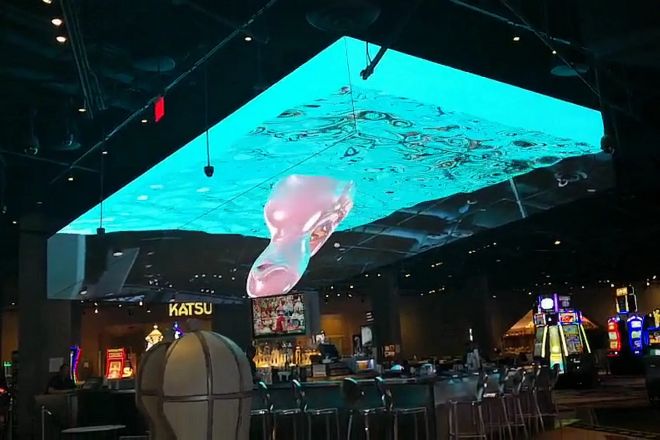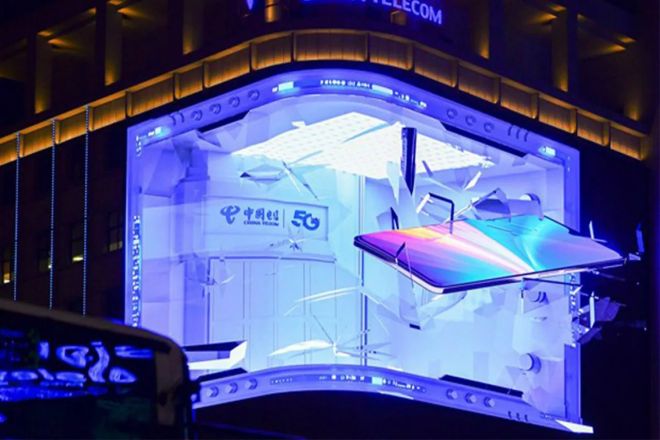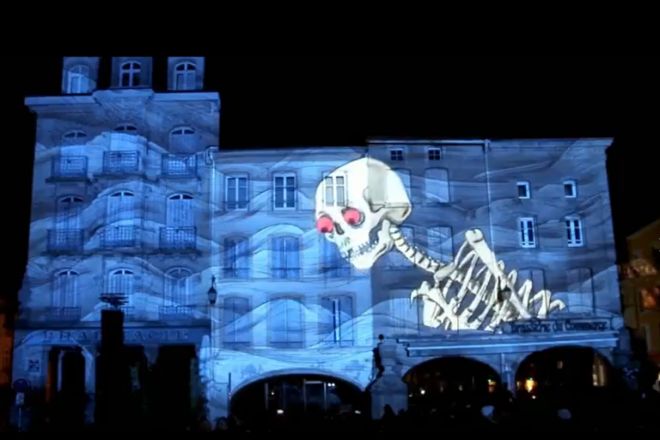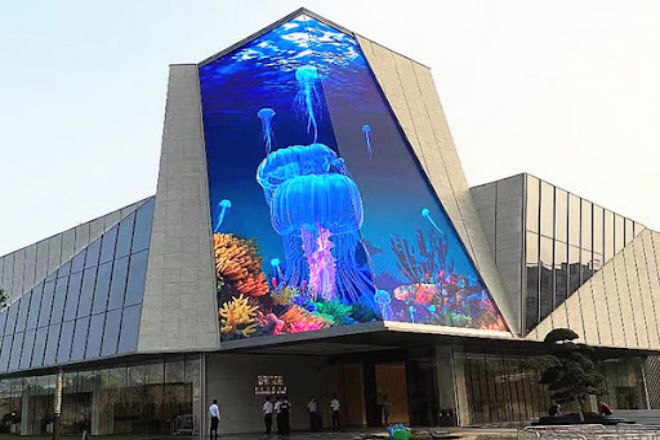介绍

With the rapid development of science and technology, visual experience technology is constantly breaking through traditional boundaries and bringing us an unprecedented sensory feast. 3D LED显示屏 shine in advertising, exhibitions, stage performances, and other fields with their excellent performance, such as high definition, high brightness, and high contrast.
Holographic projection technology, with its unique imaging method and interactivity, makes the audience feel as if they are in a virtual world full of fantasy and surprise. When these two technologies are integrated and linked with each other, what kind of shocking visual experience will be produced?
1. Overview of 3D LED display technology

A 3D LED display screen is a display screen made of LED lamp beads, which has the ability to display three-dimensional images. It is usually composed of many small LED lamp beads that can emit light in different colors and brightness, creating realistic three-dimensional effects through programming and control.
1). Features include:
High brightness: LEDs are high in brightness and can be used in bright environments.
Bright colors: LED has a high color reproduction and can display more vivid and realistic colors.
High contrast: LED has a high contrast and can display clearer pictures.
Long life: LED has a long service life, which can reach tens of thousands of hours.
Energy saving and environmental protection: LED has low energy consumption, which is in line with the concept of environmental protection and energy saving.
2). Display quality, resolution, and color reproduction
Display quality: The 3D LED display screen achieves a high-quality display effect through fine LED lamp bead arrangement and advanced control technology. Its high definition and delicate picture enable the audience to enjoy a more realistic visual experience.
Resolution: The 3D LED display screen supports a high-resolution display, which can present clearer and more delicate images. This enables more delicate and complex visual content to be displayed in advertising, exhibitions, and other fields.
Color reproduction: The 3D LED display screen has an excellent color reproduction effect and can accurately restore the color of the original image. This enables the display of commodities, artworks, and other items while maintaining their true color and texture.
3). Application case
- 广告领域:
In commercial advertising, 3D LED display screens are widely used in places such as shopping malls, exhibitions, and outdoor billboards. Displaying vivid and realistic three-dimensional advertising content attracts customers’ attention and enhances brand image and sales.
For example, the naked-eye 3D special-shaped screen project of Qingdao Jinmao Lanxiu City creates an immersive business experience for this city through professional LED display technology and creative content.
- 娱乐领域:
In entertainment activities such as stage performances and concerts, 3D LED display screens can be used as backgrounds or props to bring a more shocking and immersive visual experience to the audience.
For example, in the renovation plan of the SLS Hotel in Las Vegas, new media technologies such as “naked-eye 3D”, “holographic,” and “Mapping” were applied to provide hotel customers with a unique visual enjoyment.
- 展览领域:
In museums, art exhibitions, and science and technology exhibitions, 3D LED display screens can display more vivid and fascinating exhibits. By displaying three-dimensional models, animations, and other content, the audience can have a deeper understanding of the stories and principles behind the exhibits.
For example, the naked-eye 3D display screen project in Luoyang, Henan, presents the history and culture of the Longmen Grottoes to the audience in a new way through optical display technologies such as naked-eye 3D and XR technology.
2. Overview of holographic projection technology

Holographic projection technology, also known as virtual imaging technology, is a technology that uses the principles of interference and diffraction to record and reproduce the real three-dimensional image of an object.
Its basic principle is to illuminate the object with a beam of light (object light) and superimpose the reflected light (or transmitted light) of the object with another beam of reference light (usually a plane wave) on the recording medium to produce an interference pattern, namely a hologram.
When the hologram is illuminated with appropriate, coherent light, the three-dimensional image of the original object can be reproduced through the diffraction effect.
1). Imaging characteristics, visual effects, and interactivity
- Imaging characteristics:
Holographic projection technology can capture and reproduce the amplitude and phase information of the object, so the generated image has a real three-dimensional sense. Compared with traditional two-dimensional projection technology, the image of holographic projection is more vivid and realistic.
- 视觉效果:
Holographic projection technology can present images with a sense of depth and space, and the audience can watch the three-dimensional stereoscopic image with naked eyes without wearing any auxiliary equipment. In addition, holographic projection also has the characteristics of high definition and high color reproduction, which can provide a high-quality visual experience.
- 互动性:
Holographic projection technology is highly interactive. By combining technologies such as touch screens, infrared body motion capture, and sound control, the audience can interact with virtual images in real-time and get a richer experience. This interactivity not only enhances the audience’s sense of participation but also improves the efficiency and accuracy of information transmission.
2). Application Cases
- Virtual Reality (VR):
Holographic projection technology has broad application prospects in the field of virtual reality. By building a holographic projection system, users can be provided with an immersive virtual reality experience. For example, in the field of games, holographic projection technology can create realistic game scenes and characters, and improve the fun and attractiveness of games.
- Augmented Reality (AR):
In the field of augmented reality, holographic projection technology can combine virtual images with real environments to provide users with richer information display and interaction methods.
For example, in the guide system, holographic projection technology can display virtual reconstruction models of historical relics, allowing users to understand historical culture more intuitively.
- 舞台表演:
The application of holographic projection technology in the field of stage performances has been quite mature. Through holographic projection technology, a fantastic stage effect can be created, bringing a shocking audio-visual feast to the audience.
For example, in concerts, holographic projection technology can be combined with music to present colorful visual effects; in theater performances, holographic projection technology can assist actors in their performances and enhance the appeal of the plot.
With the continuous advancement of technology and the expansion of application fields, holographic projection technology will play a more important role in the future.
3. The linkage potential of 3D LED display and holographic projection
1). Complementarity analysis
- 视觉效果:
3D LED display screens bring clear and realistic pictures to the audience with their high resolution, high color reproduction, and excellent brightness performance. Holographic projection technology provides the audience with an immersive visual experience by reproducing the three-dimensional sense of objects.
The combination of the two can produce richer and more three-dimensional visual effects, making the audience feel as if they are in a real and dreamy world.
- 互动性:
Holographic projection technology is highly interactive and can interact with the audience in real-time. 3D LED display screens can interact with the audience through technologies such as touch screens.
The linkage between the two can further expand the form of interaction, allowing the audience to participate more deeply in the display content and gain a richer experience.
- 创新:
The linkage between 3D LED displays and holographic projection can break the limitations of traditional display methods and create a new display form. This innovative display method can not only attract the audience’s attention but also stimulate the audience’s imagination and creativity, bringing unprecedented experience to the audience.
2). Technical difficulties and solutions
- Technical integration:
It is a technical challenge to effectively integrate 3D LED display and holographic projection technology. It is necessary to solve the differences between the two in imaging principles, display methods, control systems, etc. to achieve seamless docking. Solutions include developing general control software, optimizing display algorithms, etc.
- Synchronicity:
In order to ensure the smoothness and accuracy of the linkage effect, it is necessary to ensure the synchronization of 3D LED display and holographic projection in content, rhythm, action, etc. This requires precise synchronization control technology and data transmission technology.
- Hardware compatibility:
There may be compatibility issues between 3D LED displays and holographic projection equipment of different brands and models. It is necessary to formulate unified interface standards and communication protocols to ensure the interconnection between devices.
3). Potential analysis
- Improve audience experience:
The linkage between 3D LED displays and holographic projection can bring a more shocking and realistic visual experience to the audience. The audience can immerse themselves in the three-dimensional and vivid display content and gain a deeper feeling and understanding.
- 拓展应用场景:
The application scope of linkage technology is wide, covering multiple fields such as advertising, exhibitions, stage performances, education and training. Through innovative display methods, more audiences and participants can be attracted, and the attractiveness and influence of the event can be improved.
- Promote technological development:
The research development and application of linkage technology will promote the further development of 3D LED display screens and holographic projection technology.
With the continuous advancement and innovation of technology, the visual experience in the future will be more colorful and real. At the same time, the application of linkage technology will also drive the development and upgrading of related industries and inject new impetus into economic and social development.
4. Technical challenges and future prospects

1). Current technical challenges and limitations
- Technical integration and synchronization:
There are differences between 3D LED display screens and holographic projection technologies in imaging principles and display methods.
To achieve effective linkage between the two, it is necessary to solve the problem of technical integration and synchronization. This involves issues such as the compatibility of hardware equipment, the synergy of software systems, and the real-time nature of data transmission.
- 成本高:
The research and development, manufacturing, and maintenance costs of holographic projection technology are high, and the requirements for equipment are also relatively strict, which limits its popularity in commercial applications.
The linkage with 3D LED display screens will further increase costs, which is a challenge for scenarios with limited budgets.
- 环境适应性:
Holographic projection technology has high requirements for the environment, and factors such as light and background noise may affect the clarity and stability of the projection effect.
In outdoor or light-intensive environments, the effect of holographic projection may be affected to a certain extent.
2). Means to overcome challenges
- 技术创新:
Through continuous technological innovation, improve the performance and stability of 3D LED display screens and holographic projection technology, reduce costs, and improve environmental adaptability.
For example, develop more efficient projection materials, optimize projection algorithms, and improve the compatibility and reliability of hardware equipment.
- 政策支持:
The government can support the research development and application of 3D LED display screens and holographic projection technology by formulating relevant policies.
For example, provide financial support, tax incentives, talent training, and other support measures to encourage enterprises to increase R&D investment and promote technological innovation and industrial upgrading.
- 跨境合作:
Strengthen cooperation and exchanges with other fields to jointly promote the development of 3D LED display screens and holographic projection technology. For example, cooperate with film and television production, game development, advertising creativity, and other fields to jointly explore new application scenarios and business models.
3). Future development trends and application prospects
- 技术集成与创新:
With the continuous advancement and innovation of technology, the integration of 3D LED display screens and holographic projection technology will be closer, presenting more diversified and personalized application scenarios. For example, in the field of entertainment, more realistic virtual characters and scene reproduction can be achieved.
In the field of education, an immersive learning environment can be created to improve learning effects; in the medical field, it can be used for surgical navigation disease display, etc.
- Cost reduction and popularization:
With the maturity of technology and the intensification of market competition, the cost of 3D LED display screens and holographic projection technology will gradually decrease, making it more popular and close to the people. This will further promote its application in commercial advertising, exhibitions, stage performances, and other fields.
- Environmental adaptability and intelligence:
The future 3D LED display screen and holographic projection technology will pay more attention to environmental adaptability and intelligent development. For example, by adopting more advanced projection materials and algorithms, the stability and clarity of projection effects in different environments can be improved; by introducing artificial intelligence technology, more intelligent content creation and display methods can be achieved, etc.
结论
Through an in-depth analysis of the 3D LED display and holographic projection linkage technology, it is not difficult to find that the combination of these two technologies not only brings us an unprecedented visual feast but also opens up a new development path for the future visual experience.
Although there are still some technical challenges and limitations, with the continuous advancement and innovation of technology, we have reason to believe that the future visual experience will be more colorful and real.
最后,如果您想了解更多关于LED显示屏的知识, 请与我们联系。
